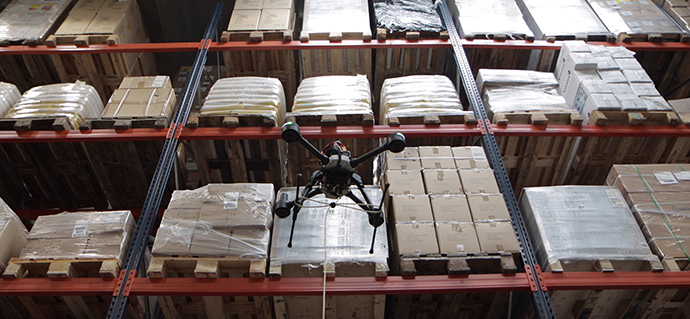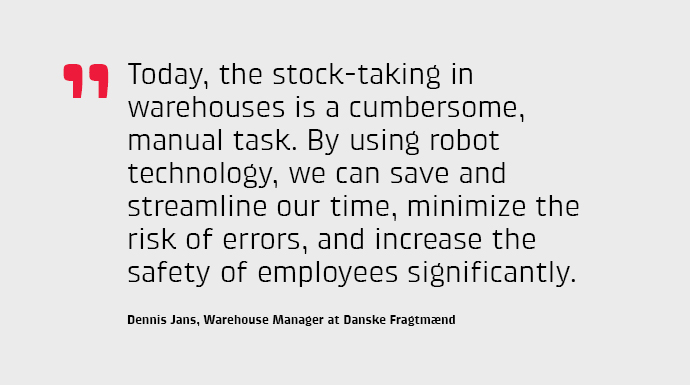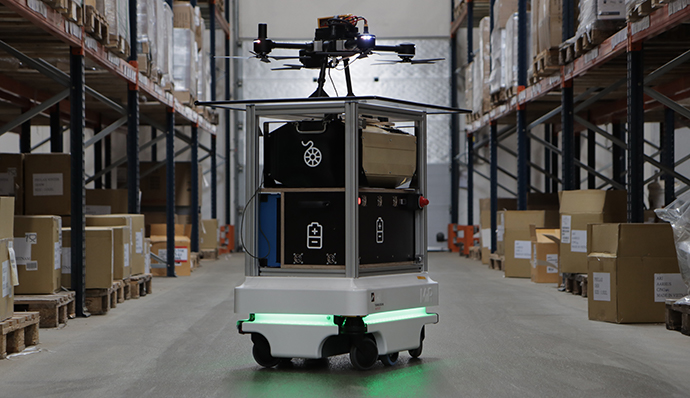A necessary automation: Robots for stock-taking in warehouses
The employees at Danske Fragtmænd must use a lift to inspect their warehouse in the heights. In a project, the Danish Technological Institute, together with Elistair and MapsPeople, has investigated whether it can be made easier, safer, and more efficient with robot technology.
When the warehouse employees at Danske Fragtmænd go home, an autonomous drone could very well take off and fly around between the warehouse shelves, which are often several meters high. The drones were to check bar codes on the various pallets, check the inventory on the individual pallet sites and do other warehouse management work, which has been the employees of Danske Fragtmænd's task.
A European project under the name TEDAI (Tethered Drones for Semi-Automated Inventory Checking) has been working on that scenario.
The project's three partners - the Danish Technological Institute (DTI), Elistair and MapsPeople - have investigated how a mobile robot and a drone together can automate inventory in high storage warehouses.

- A stock count in my warehouse requires about six employees and some of the customer's representatives, and it takes a whole working day. The employees must either go up on lifts which is several meters high, or they must pick up the pallets from the heights with a truck, says Dennis Jans, Warehouse Manager at Danske Fragtmænd in Brøndby in Denmark and continues:
- We could eliminate that work by automating with, for example, a mobile robot and a drone, and there is really great potential in that.
The drone does the work
The three partners have worked on integrating a drone and a mobile robot with an advanced "tether", which is a Kevlar-reinforced drone cable, as well as an indoor navigation system.
- The mobile robot drives to a planned destination using an indoor navigation system. Once it has reached its destination, it launches the drone into the air. The drone is constantly connected to the mobile robot with the cable. The drone must read barcodes and QR codes to verify the item and ensure that the right item is in the right place. In addition, it also takes a picture, which is stored in a picture library that Danske Fragtmænd can access, explains Jonas Bæch, who is a specialist at the Danish Technological Institute.
- When the drone lands again, it finds the landing platform using the LED lights on top of the mobile robot. With the help of the mobile robot and the tether, the drone can fly around the warehouse for several hours continuously and perform a complete warehouse check without landing, he adds.
The collaboration of the mobile robot, the drone and the cable can help to create an overview of the stock, errors, deficiencies or, for example, unidentified goods that can be collected in the existing storage system.
Using images combined with barcodes from the drone, employees do not need to have access to the high shelves in the warehouse.

Storage drones as a necessity
Warehouse Manager Dennis Jans has no doubt that the potential of robot technology for stock-taking in warehouses is a necessity.
- Today, the stock-taking in warehouses is a cumbersome, manual task. By using robot technology, we can save and streamline our time, minimize the risk of errors, and increase the safety of employees significantly, says Dennis Jans and adds:
- In many ways we can see that we will have to do something different than what we are doing now. The demand and requirements for inventory management are becoming larger and more complex, at the same time as we are facing a shortage of labor. If we use the technology, we will be able to use our employees for what we need and save them for all the other tasks.
A revolutionary system
The three project partners all contribute with relevant competencies within the project area.
Elistair is a global leader in the production of drone systems with tether cables, while MapsPeople is a global leader in indoor mapping and navigation.
The Danish Technological Institute, which has many years of experience in developing robot solutions, has created the entire system that makes the drone work together with the mobile robot, so that it becomes a single unit.

French Elistair's tether will both supply the drone with battery as well as increase the security and speed of data transfer between the mobile robot and the drone. In other words, it will ensure that the drone stays where it needs to be and that the drone does not run out of battery.
- The tether acts as an anchor, so the drone is more precise in its movement. The system is revolutionary and can really make a big and important difference in warehouse inspection, says Project Manager from Elistair Antoine Haag.
Rasmus Steenberg Andersen, CIO at MapsPeople, thinks the project is exciting and important.
- This is about indoor mapping and navigation as a decision basis and a support system for robot and drone-based technology, and it has been an exciting extension of what we usually see our indoor mapping platform, MapsIndoors, used for, he says.